During the recent decade, the trump tariffs or so-called have become a very much central phrase in trade-orientated discourses around the world. With its inception under the term of the previous U.S. President Donald Trump, the tariffs not only have shifted the course of U.S.-China relations but have also affected the global supply chain, including emerging economies like India. In today’s interconnected economy, trump tariffs still influence global policy, manufacturing, and trade.
What Were the trump tariffs?
The term “trump tariffs” generally describes a series of import tariffs that were imposed in the United States in 2018, under the so-called Trump administration’s “America First” policy. These tariffs were implemented to curb the trade deficits that the U.S. was running and encourage domestic manufacturing, from the viewpoint of the U.S. government. In essence, tariffs were slapped on countries that included metals, solar panels, washing machines, and much more. China was the heavyweight under scrutiny, with imports upward of $360 billion affected.
While the claimed purpose was to protect industries and jobs within the U.S., the actual results were far from simple. The U.S. and China escalated tariff wars rapidly, affecting many countries deeply embedded in the global supply chain—India among them.
How trump tariffs Affected the Global Economy
Any new tariffs by Trump resulted in a reprisal of tariffs from the trading partners. China kickstarted a volley of retaliatory tariffs on American goods, thereby escalating the situation into a trade war. The global economy underwent instability as uncertainty gripped major industries such as electronics, automotive, and agriculture.
Multinational companies had to rethink their sourcing and manufacturing strategies. The output was moved from China in large numbers to dodge the tariffs imposed by the United States. This unwittingly created opportunities for other nations, especially in Southeast and South Asia.

The Ripple Effect on India
India, as one of the fastest-growing economies globally, has experienced an impact, albeit certain ways, following the trump tariffs:
- Export Possibilities
As U.S. firms reduced reliance on China, India emerged as an alternative for electronics, pharmaceuticals, and textiles, boosting the ‘Make in India’ initiative.
- Steel and Aluminum
- Agri Trade
Unlike China, which boosted U.S. soybean imports after the Phase One deal, India saw reduced demand as trade dynamics shifted. China trade created uncertainty for India’s agricultural exports.
- Oil Price and Currency Volatility
” trump tariffs lowered global oil prices and heightened currency volatility—both key concerns for oil-dependent India. Also, the increased cost of fuel and an unsteady rupee landed inflation and trade balance in opposite directions.
Trade Diversion and India’s Strategic Advantage
One indirect benefit has been trade diversion. The U.S. imposed tariffs on Chinese goods, which made importers look toward their other options. That caused a window of opportunity to open for Indian exporters regarding sectors of garments, machinery, and chemicals. Infrastructure and regulatory hurdles limited India’s manufacturing boom, but global attention still shifted its way.
The Post-Trump Landscape: Are the Tariffs Still in Place?
After Donald Trump left office in 2021, most of the Trump tariffs still remained in effect. President Biden has cautiously kept most tariffs, balancing political optics with post-COVID recovery and ongoing geopolitical tensions.
These tariffs and more so the effect of their continuance provide countries like India with strategic leverage if their ability to build a manufacturing base, work through the calories of past issues-an instance being labor reforms, infrastructure bottlenecks, and trade policy consistency-were to go ahead efficiently.
Lessons for India and the Developing World
Some valuable lessons were obtained during the era of Trump tariffs:
- Trade needs to be governed by geopolitics: Modern trade no longer focuses solely on economics; nations now use tariffs as tools for negotiation, power, and influence in geopolitics.
- Need for Diversification in Supply Chains: Paying a high price for heavy supply concentration in one country stands as strategic risk. India now has a chance to offer itself as an alternative to China, one that is reliable and democratic.
- Self-Reliance and Reforms: India pushes for Atmanirbhar Bharat; This approach reflects some protectionist ideas similar to the Trump tariffs but with a local touch. Yet policymakers must balance protectionism with openness and reform for it to succeed internationally.
What the Future Holds
With the lead-up to the 2024 U.S. elections, tariffs matter again in the headlines. Many expect a possible intensification of trade barriers if Donald Trump should get re-elected, including fresh rounds of trump tariffs. He had indicated tariffs of 10 percent on all imports on his possible return to office, which could be a disruption to trade once again.
For India, the key is to be flexible. Wether Trump tariffs will stay, increase, or phase out should teach countries a lesson to stay agile in their trade relationships and build resilient supply chains.
Era Trump tariff saw much more than a simple political move — it was a tectonic shift in the very understanding of trade, nationalism, and economic diplomacy. For India, it became a set of problems and opportunities. Diverted trade flows and markets constrained some industries, while others found new opportunities to expand and diversify.
In a landscape that continues to morph parallelly with changing global trading, trump tariffs now call to mind that economic reasoning today cannot be divorced from geopolitical intent. India stands at a juncture — poised on talent, demand, and possibilities — and how it picks up and responds to global tremors such as the Trump tariffs would make all the difference in carving out its space in the 21st-century economy.



0 Comments